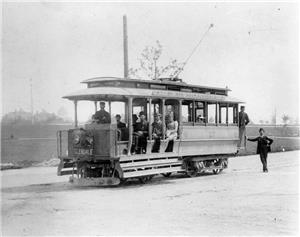On February 10, 1890, Tacoma's first electric trolley cars zip along the city streets as crowds cheer. Tacoma has had horse-drawn and steam-powered streetcars since 1888, but they are unreliable. In 1889, the Tacoma Street Railway announced plans to convert to electricity, a much more efficient method of propulsion. After nearly a year of complications, the power station has been completed, the trolley poles erected, and the trolley cars outfitted. On the big day, "the multitudes lifted up their voices and cheered until every throat was parched" (Hunt, 473). Hundreds of people are given free rides. The following Sunday, 4,000 people ride the new trolley cars. This inaugurates Tacoma's electric trolley era, which lasts until 1938.
More Efficient Propulsion
At the time the electric trolley debuted, bustling Tacoma was "staggering under a boom of the boomiest," in the words of British author Rudyard Kipling (1865-1936), who visited the Pierce County city in 1889 (Kipling, 44). This boom included a burst of street-rail construction. In 1888, a horse-drawn streetcar line had been built on Pacific Avenue and a steam-propelled line had been built on C Street, both in the heart of downtown. By 1890, "every street from Ninth to Fifteenth inclusive had been staked out for carline uses" (Hunt, 460). However, these projects remained in the planning and construction phases.
Meanwhile, Tacoma Street Railway's horse-drawn and steam-powered lines were inefficient and unreliable -- Kipling noted that the steam streetcar jumped the track the only time he tried to ride it. By this time, a new and much more efficient form of streetcar propulsion -- electricity -- had been perfected in other cities. Work on conversion to electricity in Tacoma began in March 1889, but it ended up taking nearly a year to complete. A local newspaper ran a tongue-in-cheek list of some of the delays, including "the engineer lost a suspender button," and "the dynamos caught cold sleeping out in the wet o' nights" (Hunt, 474).
In December 1889, the Tacoma Street Railway acquired new owners, who announced that they intended to replace the horse-drawn and steam-powered cars with electric trolleys "as soon as the change could be made" (Hunt, 473). The new owners immediately built an electric power plant at 13th and A streets, complete with a 75-foot smokestack. The new electric streetcars were fitted with trolley poles to hook up to electric wires strung overhead (which is why electric streetcars acquired the nickname "trolley cars").
Electric Trolleys Arrive to Cheers
Finally, the first day of electric operations arrived. A Tacoma newspaper said it was "no wonder the people went half wild," because they had been waiting so long for that day (Hunt, 473). The first trip was a trial run at 11 a.m. on February 10, 1890, and the passengers included the street railway manager, his friends, and a reporter. When the motorman clanged the trolley's gong, the town woke up to what was happening.
"Windows went up with a bang. Crowds in the restaurants left their meals, the saloons disgorged, the games of pedro, poker and faro were deserted and within ten minutes the avenue was crowded with people who cheered again and again" (Hunt, 474).
People jammed onto the trolleys the rest of the day. The electric motor passed one important test when one car attempted to climb the Ninth Street grade -- and was successful on the second try. The crowds once again cheered. The next day, hundreds of people were given free rides on the new trolleys. The next Sunday, February 16, 1890, more than 4,000 passengers rode Tacoma's electric streetcars.
This was the beginning of the electric-streetcar era in Tacoma. Within months, new lines began to crisscross the city. Tacoma residents would soon be able to get almost anywhere in the city on electric streetcars. A jumble of competing streetcar lines would later be combined under the name Tacoma Railway & Power, later part of the Puget Sound Traction, Power & Light Co. (today's Puget Sound Energy).
By the 1920s, automobiles would begin to cut into the electric-trolley business in Tacoma and the rest of the U.S. By the 1930s, Tacoma's trolley ridership was in terminal decline and the company began switching to buses. The final day of the electrical-trolley era in Tacoma arrived on June 11, 1938, when the streetcars made their final run on the city's streets. The mayor declared it to be a public holiday, and revelers stripped the trolley cars bare for souvenirs.

